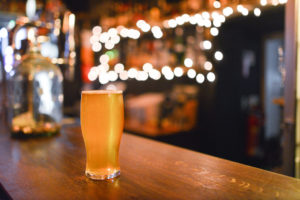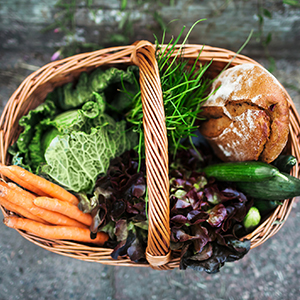Open a restaurant menu and you will often find a specific wine suggested to pair with a particular dish. But what if you prefer a crisp lager over a fruity Riesling? Certain beers pair just as well with food as wine does: Hefeweizen goes nicely with haddock, for instance, while IPAs are a fine complement to spicy food.
Restaurants all over the country are incorporating beer into their menus, and those who enjoy entertaining at home are considering their own menus. Is it OK to braise a turkey in pilsner? Which dark ale should you add to a beef carbonnade? Understanding the different flavors and complexities of beer can help turn any meal into an unforgettable experience.
In our recent keynote, “The Perfect Match: Pairing Beer with Food,” we explore beer styles and dish combinations with our expert panel: Doug Miller, lecturer in the Cornell University Nolan School of Hotel Administration and author of the Beer Essentials certificate program; Ari Sanders, director of tavern operations at Fullsteam Brewery; and Michael Wille, associate professor of culinary arts at the Culinary Institute of America.
What are some basic rules about pairing food with beer?
Wille: “When I’m trying to pair food and beer, I usually look for things like the flavor impact of the beer; that can range anywhere from delicate to intense. I’m looking at the body of the beer and the type of food I’m pairing it with. Some beers can be light and citrusy and fizzy. Others can kind of have malt characteristics and be dark and caramelly.
I’m usually trying to find harmonies within the flavors. You also might want to look for contrasts. If you have something in your food that might be fatty, you might want to cut that with something acidic, light, or fizzy in the beer. Harmonies and contrast, I think, are two of the most important things to take into consideration.”
Miller: “Look for how the food’s being prepared. Is it fried, so potentially more fat content? Is it grilled, so does it have a smoky element to it, in the case of a steak? Build mostly off the protein. The sauce can come into play, if there is a sauce, but I would key your pairing off how it’s being prepared and the protein or the main component of that dish.”
Is there a hard and fast rule when it comes to pairing beer with food like with wine? For example, most of us think about pairing a white wine with chicken. Does that relate to beer as well?
Wille: “When you have high alcohol, that’s going to usually intensify the heat in a dish. But when you begin to understand some of the flavors and tastes of different styles of beers and you understand complementing and contrasting, the rules are there to be broken.”
Sanders: “I’ve always thought about it as, ‘What does meat eat?’ Meat eats grain. What’s beer made of? Grain. I think beer is always a very natural complement to food. I do think it’s very important to have some intentionality when you decide to set a pairing up. What are you trying to show off? Do you want to break the palate up to reset for the next dish? Are you trying to show off the light buttery complexity of a sauce? Are you trying to show off the richness of a red meat? What you are trying to accentuate when you make your pairing is really important. Intentionality is important, but play. I won’t say rules are meant to be broken; rules help us along the way to learning.”
With beer now becoming more prominent, have you seen a change in your students’ taste buds whereas before the major focus was on wine pairings?
Miller: “I started teaching a beer course 14 years ago at the Culinary Institute of America in Hyde Park, and I would have the students try a sour beer. They were ready to throw it back at me. They just thought there was something wrong with me. And I’m talking about world-class sours like Cantillon and 3 Fonteinen. Now my students love it. One of the reasons this might be the case is we’re looking at the generation that grew up eating Sour Patch candy and sour items, so they were more accustomed to having sourness in their diet.
Also, now they’re shifting away from IPAs. When I taught the class last spring, they were indifferent about IPAs. When it came to lager or pilsner-style beers, they were all in. I’m curious to see when I teach it this spring if this indifference on IPA continues and we have another transitional shift of what’s popular amongst students.”
IPAs can be bitter. Are there some foods to pair with it to make it more palatable?
Sanders: “IPA is probably the broadest category of beer available in America right now. You’ll see an IPA that’s sitting at 135 IBUs, which is how we measure bitterness, and you’ll see one that reads sweet and juicy – almost like lemonade. What I would encourage is to think about what type of flavors you enjoy. Think about what a fruity, juicy, hazy IPA can go well with. I pair those about the way I would pair white wine, with fish or things with light buttery sauces. But every IPA is going to go great with a nice piece of fried chicken.”
Wille: “As chefs we say, ‘Fat is flavor.’ Any item that’s going to have that fat in there is going to be something that’s going to be strong enough to stand up to those IPAs and the bold flavors.”
Miller: “Also, make sure that your IPAs are fresh because IPAs do change. Those lovely, juicy, citrusy notes after about 60 days start changing to be more bitter. It’s not that they spoil or go bad, but the flavor profile changes.”
What are some things people should look for when trying to pick out a beer that they might like?
Miller: “I think the key thing is going to a place where you have a knowledgeable staff, go to your bottle shop or, depending on what state you’re in, a beer store, grocery store, whatever it may be; and talk to that knowledgeable person behind the counter. They could give you a lot of great insight about what just came in. They could make some suggestions on potential pairings. If you can get it from your local tap room or brewery, have a conversation with the people behind the counter. They’re a wealth of information and can help guide you through your beer journey.”
Sanders: “You know what you don’t like, and if you don’t like the food, you’re not going to like the pairing. If you know you don’t like bitter, it’s going to be hard to sell you on a super bitter IPA regardless. Be open to isolating what you don’t like and be open to saying, ‘I really like this thing. Help me find it.’ Again, knowledgeable staff is always key in that choice.”
Have you ever cooked with beer and what have you made?
Miller: “Yes, I’ve cooked with beer. If you look at countries like Belgium, they cook with beer on a regular basis. You go to a restaurant, and the chef is adding beer to the sauce, they’re braising with the beer. I think it also could be utilized if you have a little bit of barbecue sauce in a bottle – add a little beer in there just to shake it up and get the last little bit out. Then pour it into the pot. I use that sometimes.”
Sanders: “I always put beer in my pot roast. I generally use a dark beer. Any local stout I can find, I love in some pot roast. A good coffee porter is a great way to start braising off a pork loin. Sit it overnight in that coffee porter and then do a coffee rub. It’s one of my favorite things to do.”
Wille: “I agree with Ari on the stewing and braising. Those are fantastic culinary techniques where you do a combination of dry and moist cooking.
Ari and I were talking about battering and frying items. Beer is a really important component when you’re making a batter. When you dredge something like fish in flour and then you put it in a wet batter, that beer helps to aerate that batter and give it the light crispiness.”
What are your thoughts on a perfect beer to pair with heavy comfort food?
Wille: “I’m thinking about the malt flavor that’s going to be in those beers or maltiness, having that kind of sweetness that goes with heavy comfort food, so English-style brown ales or something along those lines.”
Miller: “I think it also depends on the weather, too. Being in Upstate New York in the winter, I’m thinking of something a little bit more robust, maybe a little bit higher alcohol, versus if you’re in Arizona where it’s still hot or Texas, maybe you are looking for something lighter like a pilsner or lager.”
What about food preparation? How might that impact pairing?
Wille: “I personally think it’s easier to craft the food to the beer. The beer has already been made, and it’s been put in the keg or the can or the bottle. When you have a taste of that beer, then you could start thinking about the notes that are in there or the alcohol content. Then you craft your food.”
What are the weirdest beers you’ve tried and were you pleasantly surprised?
Sanders: “It was a peated malt sour, and I was very surprised. It never occurred to me that the smokiness of scotch would even be nice soured.”
Wille: “The dill pickle sour, which I thought was a pretty cool, pretty weird beer. Professor Miller and I were talking about the possibilities with that, pairing it with a Reuben or a corned beef sandwich.”
Miller: “When I judged the New York State Brewers competition three years ago, the winner brewed a beer utilizing maple water. Not maple sap, but the maple water from the tree. It was absolutely delightful because it had a slight acidic note to it, almost like a sassafras note to it.”
What are your thoughts about new beer innovations?
Miller: “Beer is always reinventing. You’re now starting to look at new yeast drinks. There are students at Cornell that extracted yeast from an ancient Egyptian vessel and then brewed a beer with it just to see what would turn out. You’re starting to see innovation on lager styles. With the Craft Brewers Association, there are over 120 different beer styles recognized. Don’t get too deep in the weeds on the different variations of these beer styles. But that’s where the beer world is going. Beer is art right now.”
Final thoughts?
Wille: “When you’re pairing your food and your beer, taste both the food and the beer intermittently. Typically, you’ll have one of three outcomes: the food overpowers the beer, the beer overpowers the food, or the two products go so well together that they create more than the sum of their parts.”
Sanders: “The whole point of beer is community coming together, opening a glass, cheers-ing to friends and loved ones. If you like it, don’t be ashamed. Go out there, fly your flag about it. Enjoy the beer you enjoy.”
Miller: “Don’t get caught up in trying to make the perfect pairing. Just enjoy the company you’re with, enjoy the food, and enjoy the beer. Are there opportunities to get geeky on it? Absolutely. But don’t overthink it.”
Want more? Explore Doug Miller’s Beer Essentials certificate program delivered by eCornell.
This post has been edited for length and clarity. Experience the full keynote for “The Perfect Match: Pairing Beer with Food” on the eCornell website.



 The Beer Enthusiast
The Beer Enthusiast The Entrepreneur
The Entrepreneur The Techie
The Techie  The Health Guru
The Health Guru